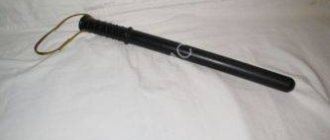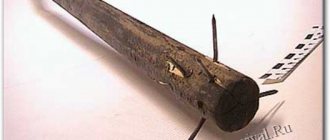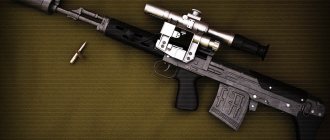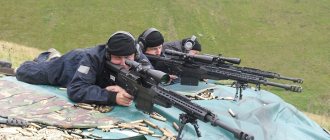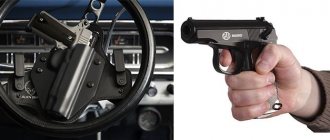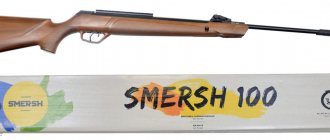Features of work related to the repair of pneumatic weapons
The operation of air guns has its own characteristics. Lack of regular maintenance and care can lead to mechanical damage. Subsequent repair work will be associated with certain difficulties. It may be necessary to replace cuffs or bypasses, install a gas spring, and also straighten the barrel.
To determine the correctness of this type of action, you should first carry out diagnostics.
Analysis of the technical condition of the weapon allows you to determine the cause of the breakdown and create a sequence of further actions.
In most cases, diagnostics are carried out free of charge, and the final cost of repair work will depend on the results obtained.
Defect detection is understood as a set of measures aimed at identifying obvious defects, as well as establishing the possibility of further use of the weapon. In this case, the level of wear of the working surfaces, the presence of chips and cracks are taken into account. In addition, defect detection allows you to determine the following points:
- the presence of rust on the metal coating of the rifle;
- traces of mechanical damage;
- presence of damage to the wooden part;
- trunk curvature.
Problems with the barrel can arise due to improper use of the weapon or be the cause of a manufacturing defect. In any case, they must be allowed.
Pneumatic cylinder repair
The importance of repairing the air cylinder is due to the fact that it acts as the main element of this type of weapon. The pneumatic cylinder consists of a sleeve, rod, piston and flanges.
Problems with each of these parts can disrupt the operation of the entire system. When performing repair work, the design features of these elements should be taken into account.
It is very important to regularly ensure that the cylinder does not have mechanical defects on the outside, and that no dirt gets into its internal cavities.
Replacing cuffs
The ideal option is to use a cuff with increased rigidity.
However, after a certain period of time, this element may wear out, resulting in the need to carry out work to replace it.
The difficulty will be that the rigid cuff fits very poorly on the piston fungus and quickly becomes unusable when trying to use improvised means.
If you resolve the problem yourself, it is recommended to follow the following sequence of actions:
- Lubricate the piston fungus with special lubricant.
- Place the cuff in boiling water (for 30-40 s).
- Remove and dry the cuff.
- Place the cuff on the piston fungus using a screwing motion.
- Perform centering.
- Cool the cuffs.
If a positive result is achieved after the cuff has cooled, you can install it in the compressor.
Replacing the bypass
The optimal bypass in an airgun is equivalent to 3.2 mm. If this indicator is lower, then maximum pressure occurs earlier and lasts slightly longer. As a result, the bullet accelerates very slowly and sluggishly. The wide bypass ensures maximum pressure later. This provides a short and sluggish bullet acceleration.
Bypass seal for Hatsan 125:
Replacing the bypass is due to the need to optimize the operation of the rifle. In this case, you can also resort to directly reducing the bypass volume or optimizing the cross-sectional diameter of the barrel gasket.
Replacing the mainspring
Replacing the mainspring is due to the fact that during operation this element can stretch. Using a weak spring leads to frequent misfires in shooting.
To carry out work to replace it, you must first remove the trigger mechanism.
In some cases, the mainspring can be pressed with a nut to compensate for shrinkage. When removing the trigger, you must hold it firmly.
You can form a spring stop and a slot through which it is best to insert the latch, presented in the form of a pin, by using a vice. When installing a new spring, remember that it compresses very poorly. The pin can be pulled out after installing the guide. After this, it is necessary to assemble the trigger mechanism and check the correct operation of the system.
Gas spring installation
The gas spring is presented in the form of a cylinder with gas, which on one side has a movable rod. This element is pushed outward by compressed gas.
This creates the force necessary to set the piston in motion. Replacing a traditional coiled wire spring with a gas spring can significantly improve shooting accuracy.
The gas spring is installed as follows:
- Removing the axle screw.
- Removing the safety button axle pin.
- Removing the stop and all its components.
- Installing a gas spring.
- Installing the centering washer.
- Installation of the stop.
- Screwing in the screw.
Installing a gas spring on a Hatsan rifle:
It is most advisable to install the gas spring into the piston with the rod inside out.
Barrel straightening
The barrel of a weapon determines the direction of flight of the bullet. The smoother it is, the projectile will fly much better and more accurately.
During operation, certain problems may arise with this element of the rifle, but the most common malfunction is swelling of the barrel.
The danger of using a weapon with such a defect is that the barrel may burst when fired. Straightening may be necessary to correct this problem.
https://www.youtube.com/watch?v=dO8cQddoyy0
Provided that the defect is not too large, the procedure can be carried out without the involvement of specialists. To do this, you need to carve a wooden sleeve from birch and insert it from the chamber side. It is very important that the wood is well dried.
The straightening procedure begins from the defective location and subsequently moves to the center. Impacts on the bushing should not be too strong, but as effective as possible. You should be very careful when straightening the joints. Before removing the bushing, you must first lubricate it.
Setting up the trigger
High-quality adjustment of the trigger mechanism improves shooting accuracy and makes the flight of the bullet more predictable. The trigger mechanism is too tight due to the high spring stiffness.
The length of the free play of the trigger can be adjusted, as well as the maximum force of the sear and trigger. During adjustment work, certain problems may arise with the fit of the fuse. This element must first be removed.
Cleaning and lubrication of air guns
To clean air guns, use a cleaning rod with an attachment and a piece of woolen cloth. For this purpose, you can also resort to using special napkins.
It is strongly recommended to refrain from using hard brushes, which can damage the inner surface of the barrel.
There is no need to remove the barrel O-ring in preparation for cleaning. The external parts of the weapon are wiped using an oiled rag. All moving mechanisms of the rifle also require lubrication.
Repair of damaged wooden parts
During use, wooden elements of air guns can become scratched, fade and lose their original appearance. The texture and color of the wood used may vary.
Repair of damaged wooden parts of air guns is carried out using special impregnation and paint and varnish . In this way, you can create a unique texture and arrive at the optimal color solution.
If necessary, the wooden part of the rifle can be darkened.
It is not recommended to use a spray to resolve this issue. Although for a small adjustment this substance will be quite enough. It should be noted that it is this impregnation that can provide reliable protection of the wooden surface from scratches and other damage of this type.
Removing bullets from the barrel
Bullets stuck in the barrel of a weapon during shooting must be removed as soon as possible. Otherwise, further use may result in the rifle being damaged.
The optimal bullet removal technique will depend on the depth of its penetration. If it is not too far away, then you can try to solve this issue using a regular cleaning rod.
You must first remove the barrel and secure it well in a vice. After this, you should resort to using a cleaning rod.
At the final stage of the work, it is imperative to thoroughly clean the barrel.
Heat treatment and welding work
Heat treatment can increase the strength of materials used for the manufacture of individual elements of air guns. There are several variations of heat treatment, among which are hardening, annealing, normalizing and tempering.
The whole point of hardening is to heat the metal to maximum temperatures, followed by instant cooling. As a result, strength indicators tend to increase.
An equally important role in the production of weapons is given to welding work. The high quality of connection of individual elements determines the reliability and safety of operation of the rifle.
Source: https://podpricelom.com/obsluzhivanie/remont-oruzhyia.html
Gas springs produced by STAMO
The STAMO SPRINGS company produces high-quality and modern gas springs. For more than 8 years of work, our specialists have gained extensive experience in the mechanical engineering industry, which allows us to introduce effective technologies and search for the best design and engineering solutions.
Our catalog presents a large assortment of gas tool springs and accessories for them. And from our specialists you can learn about all the characteristics, selection features and prices of gas springs. Any questions you may have can be asked by phone in St. Petersburg 8(812) 407-33-54.
Replacing a spring on an air rifle - step-by-step instructions
When purchasing any air gun, you should understand that you will have to care for it and, if necessary, replace parts that have become unusable. One such part of the rifle is the spring. If these rules are neglected, over time the performance of air rifle shooting will deteriorate significantly.
What is a gas spring and how does it work?
The gas spring looks like a cylinder. There is gas under pressure inside it. At one end there is a movable plunger that moves along the length of the body. Trying to push the rod outward, the force necessary to push the piston is created. At the moment of cocking, the rod is compressed into the inside of the cylinder. When a shot occurs, the gas pushes the rod in the opposite direction.
GPs were the first to be installed in pneumatics in Britain. This happened in the early 80s at a plant owned by Theoben Engineering. The spring itself was called the “Theoben Gas Ram”. A piston was used as a cylinder in the pneumatic mechanism. Today, such systems are used even in popular rifles.
The first great popularity came to these mechanisms after they began to be used to open car trunk doors. Even now, a number of large air rifle manufacturers make GP from parts produced for cars. This is due to the reliability of the technology and its versatility.
Speaking about the Hatsan company, they abandoned this technology. GPs are produced with pumping valves that fit the standard fittings of branded high pressure pumps. The gas spring itself consists of several parts:
- housing (sealed) with gas inside;
- centering and restraining rod rim;
- stuffing box reservoir (for sealing);
- plunger (rod).
As mentioned above, a number of GP models are produced based on a mechanism for opening the trunk of a car. But for this, manufacturers use only the main elements, that is, the rod, its sealing gland, plunger and reservoir shell. The centering support washer, rim and reservoir are produced separately.
Only typical high-pressure gas pumps fall under this description. Speaking about low-pressure gas pumps, it is not customary to use gas stops as blanks. Each part of the mechanism is produced according to individual drawings.
Main advantages of GP
Most owners of pneumatics with gas springs prefer this system due to the following advantages:
- a rifle with a GP has less recoil. There are also no various parasitic unpleasant vibrations that disturb the shooter. Thus, there is a much greater chance of hitting the target;
- when compared with a coil spring, the GP affects the reduction in trigger force;
- the platoon is uniform regardless of the entire segment of movement. At the end, the shooter puts in less effort. There are also no crunching or squeaking sounds characteristic of coiled springs;
- speaking of power, the characteristics declared by the manufacturer will in practice be as close to the truth as possible, which is not always possible to say about systems with coil springs.
The GP lasts 6-8 times longer. But for this, the shooter must regularly care for the pneumatic and clean it every time after use in an aggressive environment.
When the pneumatics are charged, the load on the remaining parts, which is created by the spring, is much less, which also has a positive effect on their service life.
Regarding mechanisms with coil springs, they try not to keep them in the cocked position. This rule does not apply to systems with GPU.
Disadvantages of GP
Studying information about gas springs, one can conclude that they have no disadvantages, but this is not the case. One of the disadvantages is temperature dependence.
This is because the force on the rod depends on the weather. Like other pneumatics, it is not advisable to use rifles with GP in severe frost.
It is harmful because the metal loses its strength, the lubricant thickens, and polyurethane and rubber seals harden, which can lead to damage.
Rifles with GP are not recommended for purchase by shooters who do not like to care for their weapons.
A GP is a mechanically complex product for an amateur, therefore, if a person does not clean it in a timely manner or installs any parts incorrectly, this will affect the service life and shooting characteristics.
Gas springs are also more sensitive to mechanical abrasive contaminants, which will also reduce the service life of the spring.
Common spring failures
Almost all gas spring failures are associated with loss of pressure. This happens over time, regardless of the model of pneumatics. But some gun owners try to increase the system's power by changing the pressure to match the levels of more expensive rifles. Technically, the shooter can do this, but in reality, it will lead to negative consequences.
After some time, the rifle will definitely fail due to the breakage of the spring itself or other parts damaged due to excessive pressure for which they are not designed.
The pressure must clearly correspond to the model, since the spring force is always selected based on the volume and diameter of the cylinder.
In addition, it has an optimal value, which is necessary for reliable operation of the mechanism without overload.
If the pressure does not match the model, this will lead to breakdowns that are difficult to predict, and the pneumatic itself will not receive an increase in power.
To increase the speed of the bullet at takeoff, experienced shooters advise replacing the GP and a number of parts on which it puts stress during shooting.
But without experience in such work, it is better not to start and seek help from professionals who will recommend a trusted manufacturer and suitable parts.
Replacing a spring in an air rifle - step-by-step instructions
Regardless of the model of air rifle, replacing a gas spring almost always follows the same principle. In this case, replacing the GP will be considered using the example of the Hatsan rifle.
Step 1
Disassembly. Before disassembling, the owner of the pneumatic gun must have a clamp. You will need it because the trigger mechanism of most air rifles is secured with pins. And the pins themselves are preloaded with a mainspring.
Therefore, you need to tighten the back, which cannot be done manually. First you need to unscrew the 4 side screws and another screw, which is located behind the trigger. Now the stock can be separated from the mechanism. Next, you should knock out the cotter pin of the safety lever and disconnect it.
Now the screw securing the rear support of the GP is unscrewed.
The picture below shows how the spring was deformed after about 3000 shots.
Step 2
Installing the spring in the piston and measuring the precompression of the GP (the preload should be at least 3 millimeters).
Step 3
Disconnecting the spring guide from the stop (rear) and leveling the plane using sandpaper.
Step 4
Drill a hole.
The recess should be 2-3 millimeters and the diameter should be 10 mm. A centering washer is inserted into it. It usually comes complete with a spring. To make it more convenient during assembly, the washer is fixed using auto-sealant (any synthetic-based glue can be used).
Step 5
Installation of the stop.
To make it more convenient to install the stop, during compression of the GP, it is allowed to cut off its rear part, as shown in the figure.
Step 6
Completion.
The rifle should be securely mounted in the clamp and the stop should be pressed into its original position. Next you need to insert the cotter pin and screw in the screw. It doesn’t matter what the design of the clamp will be.
The main thing here is to securely fix the rifle, since when the GP is compressed by the clamp screw, there is a risk that the stop will come off, and a sharp compression of the rod will cause damage to the spring.
The rifle is assembled in the reverse order.
Precompression
Precompression is the distance by which it is necessary to compress the gas spring at the time of its installation, overcoming the resistance of the rod. For example, a master disassembled an air rifle and pulled out the spring. If it is not reinstalled, the rifle can be assembled by hand without any effort. The backdrop fits without resistance, and all screws and pins also fit without problems.
Once the spring is inserted, whether coiled or gas, all screw and pin holes are adjusted to overcome the resistance of the spring. Thus, the master presses her.
The process is called precompression because it is preliminary compression.
Speaking of coil springs, it is small, so when assembling the master puts in less effort, which allows the replacement to be carried out without any additional equipment.
Regarding GP precompression, it ranges from 2 mm to 30 mm. The specific indicator depends on the model of the air rifle. It is important to understand here that the minimum value should not be 2 mm.
Such advice is given only by inexperienced masters who have not yet fully studied the issue. During the installation of the GP, unlike a coiled spring with insignificant force, the master will have to overcome a force of 50-90 kg.
Therefore, during the replacement process you will have to use a special pressing machine.
Compared with a standard spring, gas precompression does not provide any useful effect in terms of increasing the technical performance of the shot.
Therefore, it is not recommended to place washers or other parts under the spring, as this is not permitted by the instructions. Precompression should not be less than 3 mm.
If you ignore this rule while moving, the cylinder head will collect lubricant in front of itself, and if there is no or too little precompression, there is a risk of a hydraulic shock of the lubricant on the oil seal, which in the future will provoke its release outward. Shots from a rifle with a GP without clamping will lead to regular impacts of the rim on the side of the cylinder inside the GP.
As a result, the place where the rod crown is mounted or it itself will break. This can be dangerous for the shooter himself, since a broken or damaged rim will slip through the collar and pierce the body seal.
After this, the spring will quickly lose pressure. If the crown detaches from the rod or flies out, this may threaten the health or even the life of the shooter.
Therefore, it is very important not to compress the spring outside the rifle, as there is a high risk of a sudden break.
Source: https://pnevmatiky.ru/vintovki/kak-zamenit-pruzhinu-na-pnevmaticheskoj-vintovke
How to handle the rifle after purchase?
After purchasing, before using the rifle, you need to disassemble it, remove the old lubricant and apply a larger amount of another. Then install the original or gas spring. After installing a powerful spring, you need to shoot with heavier bullets, otherwise the piston hits the bypass with force, as a result of which the springs break and the cuffs burn out.
When “re-opening” yourself, securely tighten all the bolts that secure the stock to the barrel. And systematically ensure that they are always tightened to avoid breaking the stock during cocking. It is also prohibited to fire blank shots, which can lead to strong shock loads that damage the optics. And blank shots on magnum rifles will inevitably result in the stock breaking. Be careful and attentive when disassembling air guns.
It is not recommended to repair an air rifle with your own hands. Firstly, such a device is potentially dangerous. Secondly, special equipment is needed. Companies that repair air rifles only accept them unloaded.
They are spring-piston rifles of an original design for initial shooting training. For many years, the Izhevsk Mechanical Plant produced classic fractures PSR, PSRM, IZh22, IZh38. IZH60 is the first rifle with a fixed barrel and a side cocking lever. The rifle has an original layout (with a slight stretch you can say bullpup), and the IZH60.61 is also equipped with useful adjustments. The length of the stock, the trigger stroke, the trigger force, and the position of the trigger are adjustable. Separately, it is necessary to say about the descent. The rifle has a very good 3-part trigger with warning. The trigger force and trigger travel are adjustable within a fairly wide range with 2 adjusting screws (on older versions there were 3 and 4 adjusting screws). The trigger mechanism has an automatic safety that does not allow you to pull the trigger with the cocking lever open. The rifle barrel is unified with other models of Izhevsk recreational rifles. Manufactured by cold forging. The barrel length is 45 cm, the outer diameter is 13 mm, it has 6 grooves with semicircular fields, less often trapezoidal. The type of rifling does not affect accuracy and is a consequence of the use of an appropriate mandrel, and not a reduction in the cost of production, as some believe. At the end of the barrel of rifles produced after 2000 there is a 12*1 thread. The rifle cylinder is located at an angle of 5 degrees to the barrel and is a through pipe closed at the front with a plug; the internal surface is well made, with fairly low roughness. The piston is forged and has less clearance with the cylinder than in other IMZ rifles. The piston stroke is 57mm, the standard cuff is 25mm. The original spring has the following characteristics: wire diameter 2.6 mm, outer diameter 19.5 mm, number of turns 32-33, compressed length 80 mm, free length 210 mm. A piston weight is included as standard. At the rear, the spring is preloaded with a plug, which is secured by a transverse pin and a pin-axis of the cocking lever. A ratchet is installed in the buttplate, which prevents the lever from returning when it is not fully cocked. Until 2000, the rifle was produced with a metal receiver, the so-called, but you shouldn’t take everything at word, since that article was created many opinions have changed. You shouldn’t stuff a spring from the GC or from the Carpathian front fork into the IZH60, then you won’t have to change the connecting rod to a thicker one. There’s no need to stuff a paperclip into the groove of the cuff; you can put a rubber band there or fill it with silicone sealant. it is described how to complete the rammer, in principle everything is correct, but on new rifles the rammer already has an elastic band, so there is no need to complete anything. But on new rifles it is advisable to check the seal of the front compressor plug. The elastic band is often damaged due to careless assembly. All the tips for sealing IZH60 unfortunately are not suitable for IZH61, the problem is that the rings will get stuck in the magazine, and if they go through, they will be caught by the magazine stopper part. For those who are afraid to throw out the ratchet, I would advise you to pull it out and bore the backplate, so that there is about a millimeter left to the pin, then you can install an uncut spring from MP512, which I consider the best option for IZH60.61.
To improve accuracy, I advise you to make a muzzle, the weight is selected individually until a good balance is obtained, you can make the butt heavier by pouring shot with epoxy into it. Many articles recommend redoing the muzzle chamfer. Before doing this, look carefully at the factory one, although it is not beautiful, it is most often smooth, and if the rifling comes off at the same time and there are no burrs, then you don’t have to do anything, especially considering that not everyone can make a good, even chamfer at home . You can install an optical sight on the rifle. A big plus of the IZH60 is that it is not demanding on optics; almost any optics, with the exception of very left-handed and crooked ones, will work without problems. But this does not mean that you need to put down pencils. Have mercy on your eyes. The minimum reasonable scope would be a Chinese 4*32 with an inch tube
, preferably with parallax adjustment. The rifle is very convenient and unpretentious to use. In the class of non-sporting SPP rifles with a power of up to 7.5 J, this is undoubtedly a very strong participant. I’ll finish with a small selection of links.
Rifles and pistols can be carried out independently. This will require care and precision when disassembling the device and manipulating parts and replacing them. During repair work, it is possible not only to restore a weapon that is in disrepair, but also to improve the quality of its operation compared to its original condition.
How to improve the characteristics of the air with your own hands?
Air guns are commonly called pneumatic weapons for amateur shooting, in which the bullet is driven not by the energy of gunpowder, but by the pressure of compressed air.
Such weapons are used not only for hobbies, but also for sport shooting. If the weapon has low power, then it can be improved.
Increasing air power cannot be done for all models, so you should first consult with a specialist.
What is the purpose of the upgrade?
Even if you have the best car or motorcycle, you want to make it faster or more beautiful by resorting to tuning and upgrading and bringing it to perfection. It’s the same with weapons - they can be brought to perfection, improve their tactical and technical characteristics, change parts, sharpen them, etc.
Properly performed upgrades and tuning will improve the power of the shot, which expands the range of use of the weapon.
For example, if previously a weapon was only suitable for shooting at paper targets or jars, then after an upgrade it can be used for hunting or for self-defense.
Improving the parameters of pneumatics will increase the shot range. You can attach an optical sight to the weapon, with which you can hit targets at long distances.
When making repairs in a gun shop, you can install a cartridge with increased power, change the shape of the barrel channel, or replace the spring. All these changes will increase the speed of the bullet, reduce vibrations when firing and adjust the trigger mechanism, adjusting it to the owner.
Important! When upgrading weapons, do not forget that after the upgrade, the operation of some types of weapons may not comply with current legislation.
Required Tools
Upgrading air guns can be done at service centers, or you can do it yourself if you have the appropriate tools. It is important to pay attention to the quality of the tools, since most weapon improvement work requires precision and care when performed. Using alternative upgrade methods may damage the weapon or impair its shooting ability.
Before strengthening the air, you should depreserve it, that is, remove the factory grease on the weapon. This procedure must be performed not only for new, but also for used weapons.
To do this, it is better to use a soft cloth soaked in solvent or a special liquid from a gun store.
Great care must be taken in this case, since an incorrect movement can scratch the barrel, which will affect the accuracy of shooting.
To upgrade the air conditioner at home, you will need the following tools:
- high-quality hacksaw blade for metal processing. A hacksaw for metal has a narrow shape and thin teeth, so the blade is attached to it on both sides in the shape of a crescent. It has a rubberized handle so as not to wobble or diverge when carving;
- electric drill with special carbon steel drill bits that are designed for metal. Such parts can be purchased in specialized stores selling metal parts and spare parts;
- several files that are needed to process the barrel channel. They help renew, change or restore the threads in the barrel.
For a high-quality upgrade, you need all of the listed tools. The procedure should be carried out in a clean place, protected from wind and humidity.
Ways to strengthen the air
Any improvement or change in the spring-piston system of a weapon implies exceeding the performance characteristics specified by the factory during the manufacture of the air gun. Therefore, the power of the air blower must be increased gradually so that the changes do not negatively affect its performance and service life.
The chamber of such weapons is smaller in size compared to similar rifles, and therefore their firing speed is lower. There are many ways to improve the shooting characteristics of a weapon and its power, everyone chooses the right one for themselves.
Typically, after work on improving weapons, power can increase by 20-30%.
Trunk trimming
An air rifle can be converted into a sawed-off hunting rifle by shortening its barrel. If installed incorrectly, the accuracy of the air gun can be impaired, so it is better to entrust this task to an experienced technician. For this procedure, you need to use a hacksaw, but not a grinder with a round blade.
Attention! Such an upgrade will also lead to a decrease in the sight range, but will have a positive effect on the muzzle energy - it will increase several times, and accuracy will not suffer either.
Surely no one wants to spoil the appearance of a recently purchased weapon, but such an update will benefit an old, worn-out rifle.
Spring replacement
Such an upgrade involves the use of a new spring, which has several more turns than the previous one. When replacing a spring, the main rule must be observed - it must fit in the length of the weapon when cocked. In addition, you need to choose a spring from a higher quality material, the strength of which corresponds to the weapon.
A part such as a spring significantly affects the bullet’s ejection speed, so replacing it is necessary to improve the parameters of the air. In order for the design of the new spring to be superior to the previous one in all respects, you need to remove the old one from the weapon and compare it with the model purchased in the store.
Weighted bullets
Such an air upgrade will not only increase the range of the bullet, but also the penetrating capability of the weapon. For this reason, bullet weighting is often recommended by shooting athletes.
Airgun upgrades generally use flathead bullets, which are heavier in weight than standard ammunition.
These bullets are unlikely to be suitable for hunting game, since they are not capable of piercing a carcass, but only leave bruises or scratches on it.
High-quality lubricant
When moving along the barrel channel, the bullet loses some of its kinetic energy, and to avoid this loss it is important to use a high-quality lubricant.
This procedure is carried out not only to strengthen the air or its penetrating power, it should be carried out regularly to preserve the shooting parameters of the weapon.
With proper care, the bullet will easily pass through the barrel, overcoming the frictional force in it.
It is recommended to use automobile oil to lubricate the barrel; it must be new. Used oil has a different chemical composition, which can significantly change the properties of the air barrel. Another option for quality service is silicone lubricant for guns, which can be purchased at a specialty store.
Replacing fasteners
If, when firing a pneumatic gun, the shooter feels the release of air under pressure with his neck or cheek, it means that the body of the weapon is not sufficiently attached to the breech. When attaching these parts of the weapon to each other, a bolt is used. If it is not long enough, some of the air during the ejection of the bullet will fly out through the holes in the body instead of increasing the speed of its exit.
To upgrade, you need to unscrew the old bolts, then use a drill to make longer holes, and use a file to make recesses for fastening. New holes must be at least 2 mm longer than the previous ones. New bolts must be screwed in carefully, and special rubber washers must be used for sealing.
Safety measures during modernization
Air guns are not considered to be fatal when fired, but their bullets have significant penetrating power and can cause serious injury to a person.
Even if you increase the initial speed by several indicators, it will increase the energy of the shot and enhance the traumatic properties of the weapon.
Therefore, after the upgrade, you should accurately calculate the power of the weapon, the speed of the bullet and its mass.
It is important to follow the following safety rules when upgrading air guns:
- If, when replacing the spring, the new one turns out to be too strong, this can lead to deformation of some parts of the weapon. This in turn can cause a premature shot;
- if the bullet speed increases, then at a long distance it can be dangerous, so when checking an upgraded weapon you should be careful and make sure that there are no people in the direction of the shot;
- When boring the air discharge chamber, you should not allow its walls to become too thin. This procedure may reduce the rigidity of the housing, and gas escaping through damaged parts may cause injury.
What is a seal - gaskets and their replacement
The seal is a metal part of an air pistol that prevents the passage of a large volume of gas at the beginning of a shot from an air pistol. In the gas-cylinder pneumatic pistol Makarov 654K, 2 silicone gaskets are installed on the seal:
1. Above the cylinder, large white gasket of the repair kit, the replacement of which was discussed above.
2. Black o-ring on the back of the shutter needle (replacement will require disassembling the magazine).
In some cases, it is not the silicone that is to blame for a gas leak, but the seal needle, cracks, or chips of the seal. In this case, you will need a shutter assembly for the Makarov 654K pistol in Minsk, Belarus. When replacing the seal, it is best to replace the silicone gaskets as well.
Stoeger air rifles have appeared on our market quite recently. The model range of 4.5 mm spring-piston rifles is represented by three lines - Stoeger x10, Stoeger x20 and Stoeger x50. They have different optical sights and external finishes on the rifle.
Rifle stocks can be made of wood coated with a thin layer of matte varnish, or of plastic. In order to reduce recoil, there is a rubber butt pad. The Stoeger x10 stock has a simpler design than the other two, which have checkering to better grip the rifle while shooting, one or two cheekpieces on the butt for comfort, and a nice, comfortable rubber recoil pad.
Start of shooting
After assembling the rifle, it is best to try to place the rifle in your shoulder while taking aim. If you can do this in one movement, there is no discomfort - everything is fine. Otherwise, you should think about adjusting the length of the butt. In this regard, some rifle models are especially convenient, for example, the Hatsan 125, which from the factory have an adjustable butt plate with a height that can be changed using special spacers.
Don’t forget to pay attention to how you feel when shooting; there is a chance that you will have to re-adjust the changed balance of the rifle. For example, if the weapon seems too heavy from the butt side, you can install a muzzle on it, and if the barrel outweighs it, you can make the butt heavier.
Operating principle
When cocking (which requires breaking the device by resting it, for example, on the knee), the mainspring is compressed. Compressed air is forced into the piston. When the release hook is pressed, the piston disengages from the sear and pushes the lead bullet.
When breaking the barrel, the weapon immediately goes on safety. To fire, you need to pull it towards you and then press the trigger. One bullet – one shot (single-shot rifle).
The video shows the MP-512-24 air rifle in action:
Heat treatment and welding work
Heat treatment can increase the strength of materials used for the manufacture of individual elements of air guns. There are several variations of heat treatment, among which are hardening, annealing, normalizing and tempering.
The whole point of hardening is to heat the metal to maximum temperatures, followed by instant cooling. As a result, strength indicators tend to increase.
An equally important role in the production of weapons is given to welding work. The high quality of connection of individual elements determines the reliability and safety of operation of the rifle.
Pneumatic zeroing
After all these preparatory measures and adjusting the new rifle to your needs, you need to shoot it correctly. To do this, it is best to choose a calm day and an open or closed shooting range with a line at a distance of 50 meters. It is best for you to decide in advance on the type and brand of bullets that you will use in the future, because with open sights, zeroing is carried out individually for each type of ammunition. So if you later start using bullets of a different shape or weight, a new zeroing cannot be avoided.
If circumstances permit, it is better to take an electronic chronometer with you when shooting, which will allow you to measure the speed of the bullet and check whether it corresponds to that declared by the manufacturer.
If you are just starting your acquaintance with pneumatics, it is better not to rush to install an optical sight on your rifle; it would be more advisable to initially get used to your new rifle, feel its behavior, and only then install optics on it.
Optics setup
The use of optics requires a different approach to the weapon, especially when it comes to a sight for spring-piston pneumatics. It is widely known that it uses a fairly powerful spring, so the weapon will have considerable recoil. All this creates high loads during a shot. Hence, we have a tendency to at least misalign the sight settings, but it is also quite possible for the sight itself to move out of its place.
Such features have been repeatedly confirmed by a series of independent tests, the results of which revealed that the sights of only some manufacturers are able to normally withstand the recoil of spring-piston pneumatics. The best among them were optical sights produced by Leapers and Bunshell.
The sights from these manufacturers are capable of functioning normally under almost any conditions, even in low light or at twilight. Resistance to recoil is determined by the use of double rings to secure the lenses, which prevents them from moving.
For pneumatic rifles, it is most advisable to install the sight on a monoblock bracket equipped with a stopper, which will prevent the sight from moving. Zeroing optics follows different rules, weeks when using open sights, but this is a fairly broad topic and we will talk about it in another article.
It is quite possible that after installing the optics, the balance of the rifle itself will change. In such a situation, special weights can help you out, which will allow you to build your balance in a way that is convenient for you. But if you purchased a rifle with a pre-installed optical sight, then most likely its balancing already takes into account the weight of the sight.

